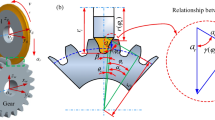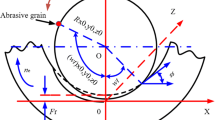Abstract
The machining quality of the blade tip has a great influence on the service performance and life of the aero-engine blade. The recent paper investigates the effect of vibration during the grinding process of the GH4169 nickel-based superalloy blade tip. Moreover, this paper proposes a theoretical model to link the unbalance of the grinding wheel, the vibration, and the surface topography characteristics of the blade. The results show that the blade vibration during grinding and the resulting non-linear change of the grinding depth could reduce the surface quality of the blade tip and lead to differences in the surface quality of the blade tip in different areas, where the surface roughness in the entry area zone I is the largest, in the exit area zone III is the second largest, and the intermediate area zone III is the smallest. Grinding depth has a greater impact on the difference of the surface quality in the blade tip grinding process, especially when the grinding depth is greater than 4 μm, the difference of surface roughness increases significantly. On the other hand, the feed rate has little effect on the difference in surface quality. Adding damping block can reduce the surface roughness of the blade tip; however, it does not reduce the difference in surface quality.



















Similar content being viewed by others
Availability of data and materials
Some or all data generated or used during the study are available from the corresponding author by request.
Code availability
Some or all code used during the study are available from the corresponding author by request.
References
Thakur A, Gangopadhyay S (2016) State-of-the-art in surface integrity in machining of nickel-based super alloys. Int J Mach Tools Manuf 100:25–54. https://doi.org/10.1016/j.ijmachtools.2015.10.001
Ezugwu EO (2005) Key improvements in the machining of difficult-to-cut aerospace superalloys. Int J Mach Tools Manuf 45:1353–1367. https://doi.org/10.1016/j.ijmachtools.2005.02.003
Yao CF, Jin QC, Huang XC, Wu DX, Ren JX, Zhang DH (2013) Research on surface integrity of grinding Inconel 718. Int J Adv Manuf Technol 65:1019–1030. https://doi.org/10.1007/s00170-012-4236-7
Ding W (2019) Review on grinding technology of nickel-based superalloys used for aero-engine. J Mech Eng 55:189. https://doi.org/10.3901/JME.2019.01.189
Mao C, Cai P, Hu Y, Zhong Y, Wei J, Bi Z, Jiang YF, Xiao LF, Zhang MJ (2021) Effect of laser-discrete-quenching on bonding properties of electroplated grinding wheel with AISI 1045 steel substrate and nickel bond. Chin J Aeronaut 34:79–89. https://doi.org/10.1016/j.cja.2020.09.010
Choudhury IA, El-Baradie MA (1998) Machinability of nickel-base super alloys: a general review. J Mater Process Technol 77:278–284. https://doi.org/10.1016/S0924-0136(97)00429-9
Ge YC, Zhu ZW, Zhu YW (2019) Electrochemical deep grinding of cast nickel-base superalloys. J Manuf Process 47:291–296. https://doi.org/10.1016/j.jmapro.2019.10.007
Ulutan D, Ozel T (2011) Machining induced surface integrity in titanium and nickel alloys: a review. Int J Mach Tools Manuf 51:250–280. https://doi.org/10.1016/j.ijmachtools.2010.11.003
Zhao X (2010) Cutting of nickel-based high temperature alloy. Aeronaut Manuf Technol. https://doi.org/10.16080/j.issn1671-833x.2010.11.020
Xu JH, Zhang Z, Fu YC (2014) Review and prospect on high efficiency profile grinding of nickel-based superalloys. Acta Aeronaut Astronaut Sin. https://doi.org/10.7527/S1000-6893.2013.0421
Li D, Li Y, Xie Q, Wu Y, Yu Z, Wang J (2021) Tiny defect detection in high-resolution aero-engine blade images via a coarse-to-fine framework. IEEE Trans Instrum Meas 70:1–12. https://doi.org/10.1109/TIM.2021.3062175
Poletaev VA, Tsvetkov EV, Matveev AS (2017) Surface quality of turbine blades in multicoordinate grinding. Russ Eng Res 37:545–548. https://doi.org/10.3103/S1068798X17060193
Österle W, Li PX, Nolze G (1999) Influence of surface finishing on residual stress depth profiles of a coarse-grained nickel-base superalloy. Mater Sci Eng A 262:308–311. https://doi.org/10.1016/S0921-5093(98)01018-1
Miao Q, Ding W, Kuang W, Yang C (2020) Comparison on grindability and surface integrity in creep feed grinding of GH4169, K403, DZ408 and DD6 nickel-based superalloys. J Manuf Process 49:175–186. https://doi.org/10.1016/j.jmapro.2019.11.027
Huang Z, Song R, Wan C, Wei P, Wang H (2019) Trajectory planning of abrasive belt grinding for aero-engine blade profile. Int J Adv Manuf Technol 102:605–614. https://doi.org/10.1007/s00170-018-3187-z
Piccioni E (2010) Blade tip grinding tooling. U.S. Patent No. 7,765,658. Washington, DC: U.S. Patent and Trademark Office
Moradi H, Movahhedy MR, Vossoughi G (2012) Tunable vibration absorber for improving milling stability with tool wear and process damping effects. Mech Mach Theory 52:59–77. https://doi.org/10.1016/j.mechmachtheory.2012.01.009
Xian C, Shi YY, Lin XJ, Liu D (2020) Study on vibration characteristics of polishing rod for polishing aeroengine blade with abrasive cloth wheel. Math Probl Eng 2020:e5472502. https://doi.org/10.1155/2020/5472502
Hou J, Zhao Z, Fu Y, Qian N (2021) Machining stability enhancement in multi-axis milling of titanium hollow blade by introducing multiple damping and rigid supporters. J Manuf Process 64:198–208. https://doi.org/10.1016/j.jmapro.2021.01.016
Lu XD, Du JH, Deng Q (2013) High temperature structure stability of GH4169 superalloy. Mater Sci Eng A 559:623–628. https://doi.org/10.1016/j.msea.2012.09.001
Li ZC, Lin B, Xu YS, Hu J (2002) Experimental studies on grinding forces and force ratio of the unsteady-state grinding technique. J Mater Process Technol 129:76–80. https://doi.org/10.1016/S0924-0136(02)00579-4
Abu-Mahfouz I, El Ariss O, Esfakur Rahman AHM, Banerjee A (2017) Surface roughness prediction as a classification problem using support vector machine. Int J Adv Manuf Technol 92:803–815. https://doi.org/10.1007/s00170-017-0165-9
GB/T 1031–2009 Geometrical product specifications (GPS)-surface texture: profile method-surface roughness parameters and their values (n.d.). http://www.gb688.cn/bzgk/gb/newGbInfo?hcno=66E973C5E04B389708207C2F28DE6A1F. Accessed 23 Apr 2021
Acknowledgements
The authors acknowledge the financial support.
Funding
This work was funded by the National Natural Science Foundation of China (51875192, 51875191), the Natural Science Foundation of Hunan Province (2020JJ4193, 2021JJ40064), and the Natural Science Foundation of Changsha City (kq2014048).
Author information
Authors and Affiliations
Contributions
All authors contributed to the study conception and design. Material preparation, data collection, and analysis were performed by WL, QC, JW, ML, YR, and AMMI. The first draft of the manuscript was written by QC and all authors commented on previous versions of the manuscript. All authors read and approved the final manuscript.
Corresponding author
Ethics declarations
Ethics approval
Not applicable.
Consent to participate
Not applicable.
Consent to publish
Not applicable.
Competing interests
The authors declare no competing interests.
Additional information
Publisher's Note
Springer Nature remains neutral with regard to jurisdictional claims in published maps and institutional affiliations.
Rights and permissions
About this article
Cite this article
Li, W., Chen, Q., Wu, J. et al. Investigation of the effect of vibration characteristics on the grinding performance of aero-engine blade tip. Int J Adv Manuf Technol 120, 4663–4679 (2022). https://doi.org/10.1007/s00170-022-09045-y
Received:
Accepted:
Published:
Issue Date:
DOI: https://doi.org/10.1007/s00170-022-09045-y




